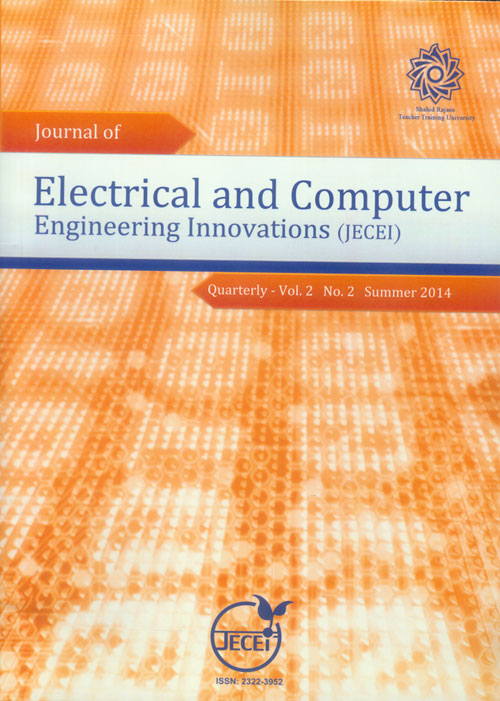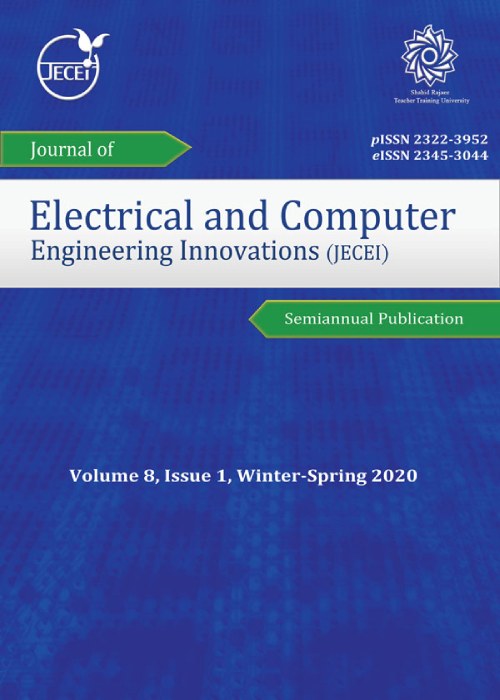فهرست مطالب

Journal of Electrical and Computer Engineering Innovations
Volume:2 Issue: 2, Summer - Autumn 2014
- تاریخ انتشار: 1393/12/14
- تعداد عناوین: 6
-
-
Pages 57-61Random Early Detection (RED) is one of the most commonly used Active Queue Management (AQM) algorithms that is recommended by IETF for deployment in the network. Although RED provides low average queuing delay and high throughput at the same time, but effectiveness of RED is highly sensitive to the RED parameters setting. As network condition varies largely, setting RED's parameters with fixed values is not an efficient solution. We propose a new method to dynamically tuning RED's parameters. For this purpose, we compute the rate of which the queue is occupied and consider it as a congestion metric that will be forecasted when the queue is overloaded. This meter is used to dynamically setting RED parameters. The simulation results show the effectiveness of the proposed method. According to the results, we achieve a significantly higher utilization and less packet loss comparing to original RED algorithm in dynamic conditions of the network.Keywords: Internet, Congestion control, Active Queue Management (AQM), Random Early Detection (RED), Self, Tuning
-
Pages 63-68In this paper, the concept of Conjectural Variation (CV) is used to specify optimal generation decision for generation companies (Gencos). The conjecture of Genco is defined as its belief or expectation about the reaction of rivals to change of its output. Using CV method, each Genco has to learn and estimate strategic behaviors of other competitors from available historical market operation data. Therefore, accuracy of generation decision depends on the accuracy of estimating other competitors’ decision within CV context. In this paper, adjusted Lerner index is used to improve the accuracy of estimating CV parameter. In electricity market, the adjusted Lerner index can be directly computed using price, market shares, marginal cost and industry elasticity of demand. It must be noted that due to repeated power market, Gencos need to modify their behavior over time. In response to this need, dynamic learning is considered in case studies which improve results.Keywords: Power market, Conjectural Variation, Adjusted Lerner index, Bidding strategy
-
Pages 69-76In this paper, a new method is introduced for sperm detection in microscopic images for infertility treatment. In this method, firstly a hypothesis testing function is defined to separate sperms from plasma, non-sperm semen particles and noise. Then, some primary candidates are selected for sperms by watershed-based segmentation algorithm. Finally, candidates are either confirmed or rejected using fuzzy entropy decision algorithm. Performance of the proposed method is evaluated on real captured images containing sperms and other specimens of semen in two different scenarios. In the first scenario, semen has low density of sperms however the second scenario belongs to semen with high density of sperms. The obtained results show the greater ability of the proposed method in sperm detection compared to present approaches in both of scenarios. Furthermore, it is shown that 8% and 15% improvements in sperm detection in the first and second scenarios can be achieved by the proposed algorithm. As the final results, the proposed algorithm not only doesnt lead to extract more false objects but also decrease the rate of false detections are decreased compared to existing algorithms.Keywords: Sperm detection, Microscopic image, Hypothesis testing, Fuzzy entropy decision
-
Pages 77-83Automatic analysis of human facial expressions is one of the challenging problems in machine vision systems. It has many applications in human-computer interactions such as, social signal processing, social robots, deceit detection, interactive video and behavior monitoring. In this paper, we develop a new method for automatic facial expression recognition based on facial muscle anatomy and human face structure. The algorithm finds approximate location of effective facial muscles and extracts features by measuring skin texture in 11 local patches. Seven facial expressions, including neutral are being classified in this study using AdaBoost classifier and other classifiers on MMI databases. Experimental results show that analyzing skin texture from selected local patches gives accurate and efficient information in order to identify different facial expressions.Keywords: Facial expression analysis, Human facial anatomy, Adaboost classifier, Support vector machine
-
Pages 85-92In this paper, the security of a distance bounding protocol is analyzed which has been recently proposed by Jannati and Falahati (so-called JF). We prove that an adversary can recover key bits of JF protocol with probability of “1” while the complexity of attack is “2n” runs of protocol. In addition, we propose an improved protocol and prove that the improved protocol is resistant to mafia fraud attack, distance fraud attack and key recovery attack.Keywords: RFID, Distance bounding protocol, Man, In, The, Middle (MITM)
-
Pages 93-99This paper presents a design of an UWB downconversion integrated CMOS resistive ring mixer with Linear Voltage Regulator (LVR), to supply required biasing voltages for the mixer section. The designed mixer circuit has been optimized for using in heart rate extraction system with microwave Doppler radar at 2.4GHz frequency. This mixer needs 2 DC bias voltages equal to 0.5 and 1 volts for its best operation. The designed LVR circuit would supply needed bias voltages. This mixer is called UWB and the changes in its necessary bias voltages would result in its weak operation. The design has been implemented in TSMC 0.18µm CMOS technology and simulated by Advanced Design System (ADS) software. Simulation results indicate good operation of regulator and mixer output during input changes.Keywords: CMOS mixers, Resistive mixers, Linear Voltage Regulators (LVR), Doppler, Heart rate extraction


